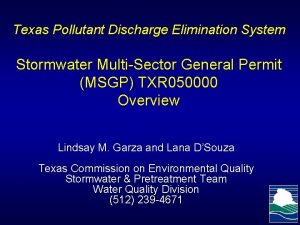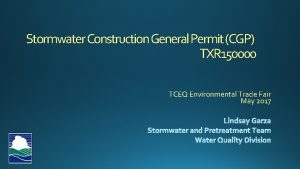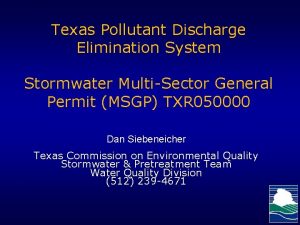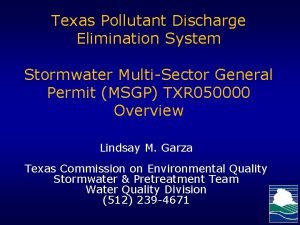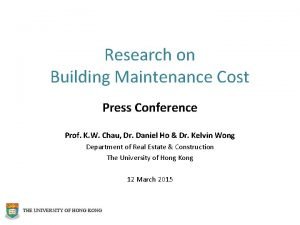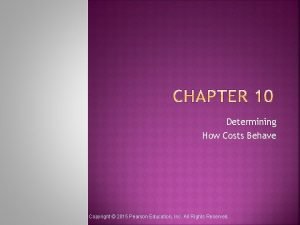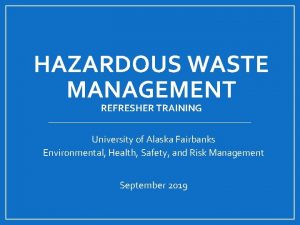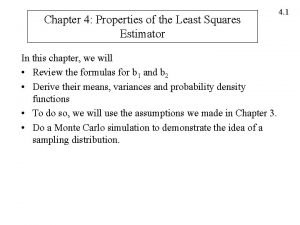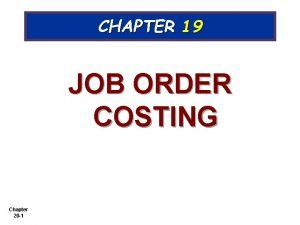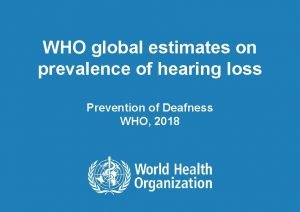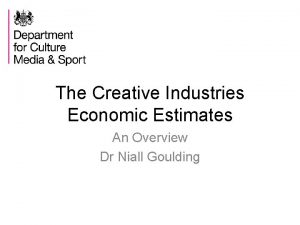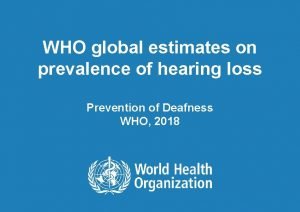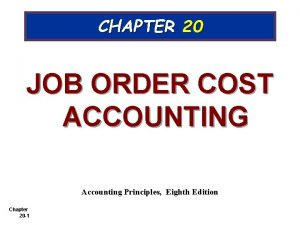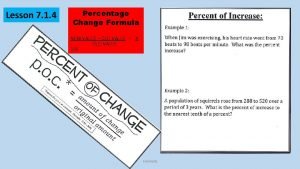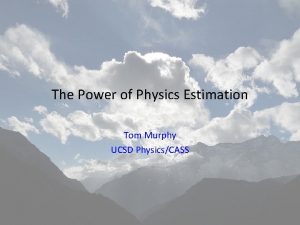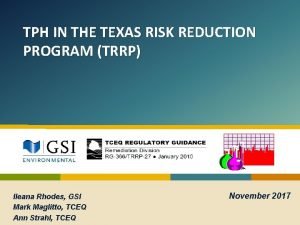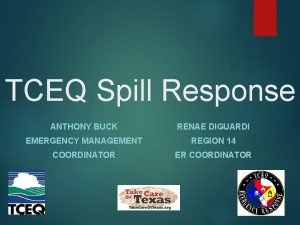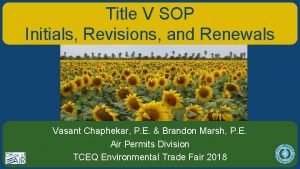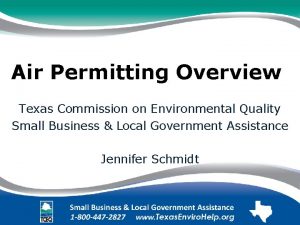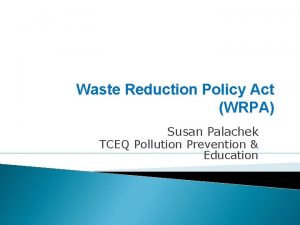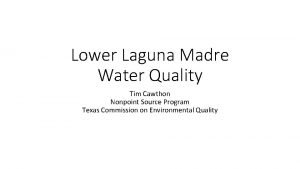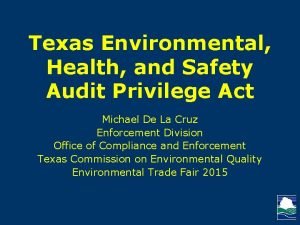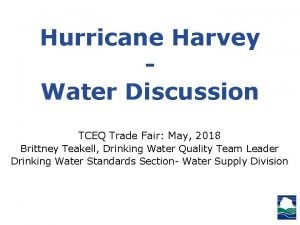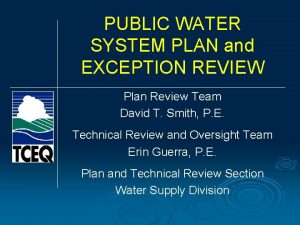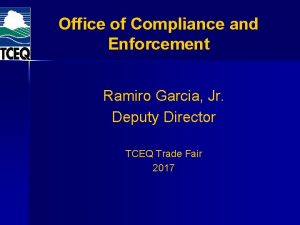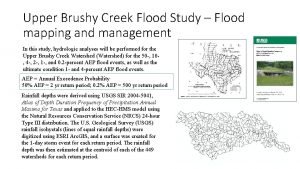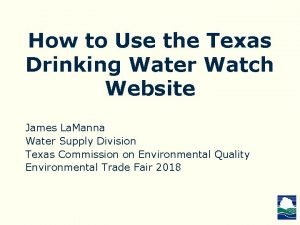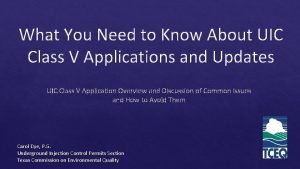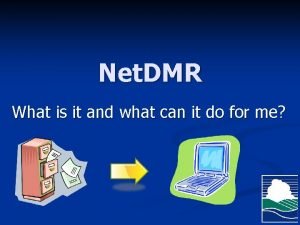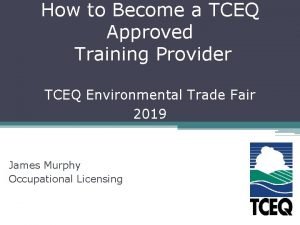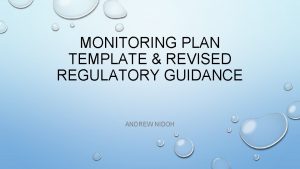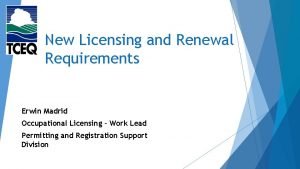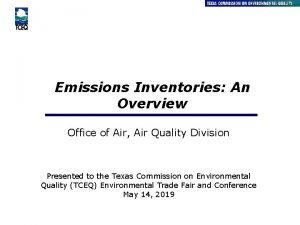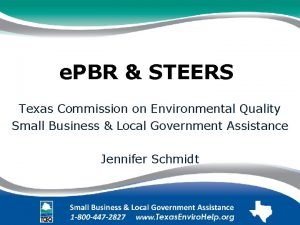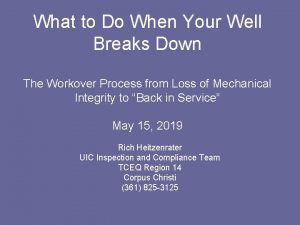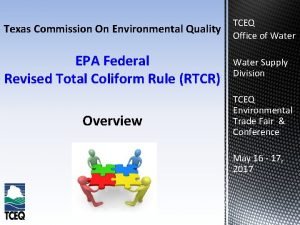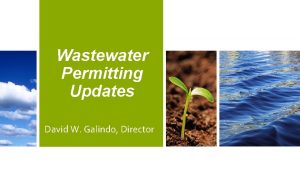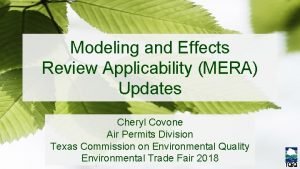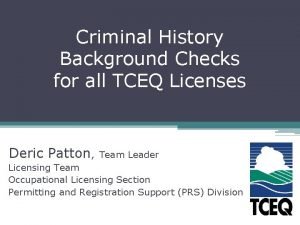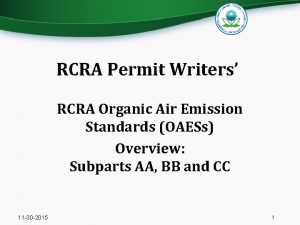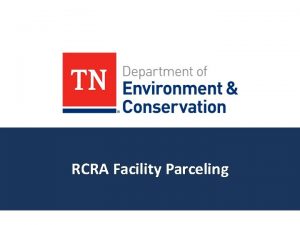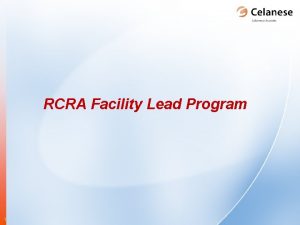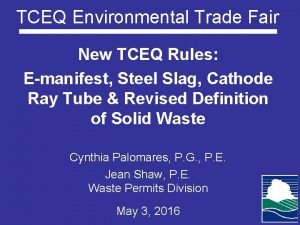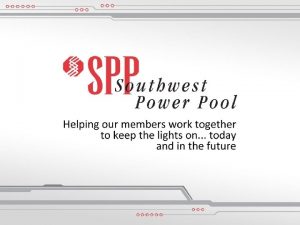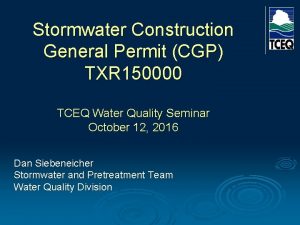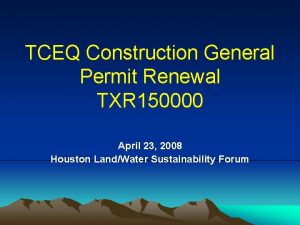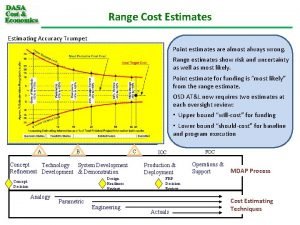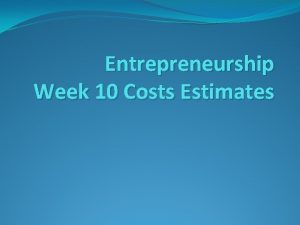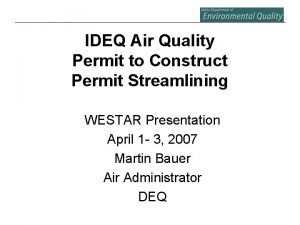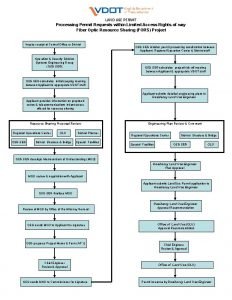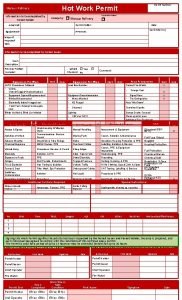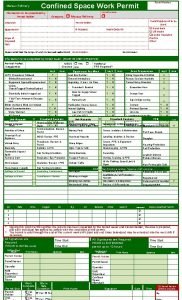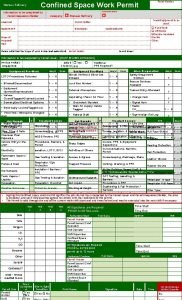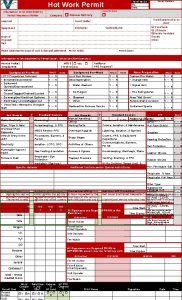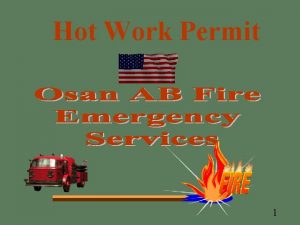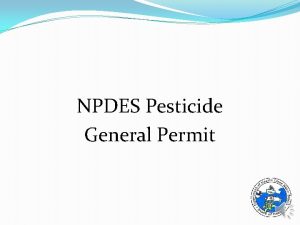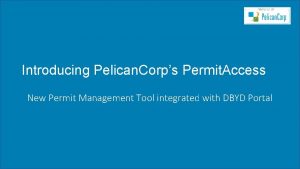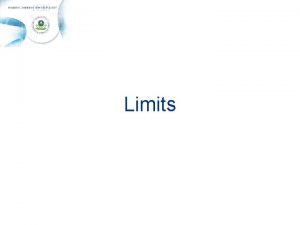RCRA Permit Closure Cost Estimates Martin Torres TCEQ



![Closure [40 CFR 264 Subpart G] Two options for Closure: Closure Types [Graphic showing Closure [40 CFR 264 Subpart G] Two options for Closure: Closure Types [Graphic showing](https://slidetodoc.com/presentation_image_h/066605ba4989ea0cda2f4d6df63e273c/image-4.jpg)

![Post-Closure Plan [40 CFR 264. 118(b)] [Graphic showing a post-closure plan must include a Post-Closure Plan [40 CFR 264. 118(b)] [Graphic showing a post-closure plan must include a](https://slidetodoc.com/presentation_image_h/066605ba4989ea0cda2f4d6df63e273c/image-6.jpg)










![Landfill [Image of landfill unit] • Summary of closure procedures • Summary of post-closure Landfill [Image of landfill unit] • Summary of closure procedures • Summary of post-closure](https://slidetodoc.com/presentation_image_h/066605ba4989ea0cda2f4d6df63e273c/image-17.jpg)








![Example [Image of an example third part contractor bid] 26 Example [Image of an example third part contractor bid] 26](https://slidetodoc.com/presentation_image_h/066605ba4989ea0cda2f4d6df63e273c/image-26.jpg)
![Example [Image of an example third party contractor bid] 27 Example [Image of an example third party contractor bid] 27](https://slidetodoc.com/presentation_image_h/066605ba4989ea0cda2f4d6df63e273c/image-27.jpg)














- Slides: 41

RCRA Permit Closure Cost Estimates Martin Torres TCEQ, Industrial and Hazardous Waste Permits Section Drew Corson AECOM May 17, 2017

Overview • Plans • Cost Estimate Requirements • Technical Guidance No. 10 • Cost Estimating Tools • RACER Overview 2

Closure & Post-Closure Plan Applicable Rules 40 CFR 264 Subpart G– 264. 280 – Land Treatment [Table showing technical General Standards standards for specific types of hazardous waste management 264. 178 – Containers 264. 310 – Landfills units Part 264 Subparts I through X] 264. 197 – Tanks 264. 351 – Incinerators 264. 228 – Surface Impoundments 264. 575 – Drip Pads 264. 258 – Waste Piles 264. 603 – Miscellaneous Units 3
![Closure 40 CFR 264 Subpart G Two options for Closure Closure Types Graphic showing Closure [40 CFR 264 Subpart G] Two options for Closure: Closure Types [Graphic showing](https://slidetodoc.com/presentation_image_h/066605ba4989ea0cda2f4d6df63e273c/image-4.jpg)
Closure [40 CFR 264 Subpart G] Two options for Closure: Closure Types [Graphic showing closure types] Clean Closure TRRP Remedy Standard A Remove waste & decontaminate site Closed- in- place TRRP Remedy Standard B Close with waste in place & cap unit (closed as a Landfill) Post-closure GW Monitoring & maintenance for 30 years 4

Closure Plan Contents Closure Regulatory Citation Closure Plan Activities [Table showing closure plan activities to include From Part 264, Subpart G in the closure plan, as well as the corresponding Facility Performance Standard closure Description regulatory citation from 40 Closure CFR Part 264, Subpart Activities G. ] Closure Plan Decontamination Final Cover Closure Performance Standard Groundwater Monitoring Survey Plat Closure Certification Certificate of Closure Schedule 5
![PostClosure Plan 40 CFR 264 118b Graphic showing a postclosure plan must include a Post-Closure Plan [40 CFR 264. 118(b)] [Graphic showing a post-closure plan must include a](https://slidetodoc.com/presentation_image_h/066605ba4989ea0cda2f4d6df63e273c/image-6.jpg)
Post-Closure Plan [40 CFR 264. 118(b)] [Graphic showing a post-closure plan must include a description of monitoring activities and their frequency, and a description of amaintenance description of monitoring activities. ] activities and their frequency A post-closure plan must include: a description of maintenance activities (e. g. , maintenance of waste containment, monitoring, security, and leachate collection systems) 6

Post-Closure Plan Contents Post-Closure Plan Activities Requirements From Part 264, Subpart G [Table showing which post-closure plan activities Facility Description General Information from 40 CFR Part 264, Subpart G are required for Post-Closure Plan Description of monitoring and maintenance activities the post-closure requirements. ] and contact information Post-Closure Monitoring Groundwater and leachate collection procedures Post-closure Facility inspections, integrity of waste containment Maintenance system, maintenance and monitoring and security systems Certification of Post. Certification of post-closure by an independent Closure licensed Texas Professional Engineer Post-Closure Notices Submit to local zoning authority within 60 days of certification 7

RCRA Closure Cost Estimates Items to Consider: • Maximum Capacity • Secondary Containment Dimensions • Equipment Surface Area • Estimated Amount of Decon Fluid needed to clean areas • Amount of Samples including QA/QC • Labor and Equipment Cost per Unit Summary • Transportation Summary • Treatment/Disposal Summary • Engineering Expenses • Closure Certification Costs • Contingency Costs • Supporting Documentation 8

Regulatory Requirements • 40 CFR 264. 142 (Closure) and 126. 144(Post Closure) • Facility cost estimates shall be based upon closure & post-closure plans • Includes detailed breakdown of the estimated cost of each task necessary to complete the required closure project 9

Regulatory Requirements • Amount of resources needed to complete each task and the unit cost associated with each required resource must be provided • The estimate must specify contingency cost estimates • Each activity listed by the plans in the permit shall be accounted for and priced in the estimates 10

Regulatory Requirements • Detailed written estimates, in current dollars: • Cost of closing the facility • Providing post-closure care • Salvage value disallowed for sale of equipment or wastes • Cannot assign zero economic value 11

Third Party Costs • Estimates shall not be based on the use of inhouse resources even if available • Parent companies and subsidiaries shall not be considered third parties for estimating purposes • Market based pricing which reflects outside contractor services should be used to develop the estimates 12

Most Expensive Options • Estimates shall reflect closure costs for each activity covered by the permits or plans • Estimates shall be predicted upon assumption that all activities are to be closed concurrently • Estimates shall include the maximum permitted quantities and volumes • Estimates must include offsite transportation and disposal options 13

Inflation • Update cost using an inflation factor • Inflation factors are provided annually • www. tceq. texas. gov/adminservices/financialassurance/revenue/annual_inflation_factors. html • Example: • Previous years cost estimate: • 2016 Inflation factor: • Total Updated Cost Estimate $100, 000 1. 3 $101, 300 • New cost estimate is basis for level of financial assurance required 14

Technical Guidance No. 10 Guidance document for estimating Closure and Post-Closure Cost Estimates www. tceq. texas. gov/permitting/waste_permits /ihw_permits/tech_guidance_index. html 15

Technical Guidance No. 10 • Waste Management Units: • Landfills • Land Treatment Units • Waste Piles • Surface Impoundments • Container Storage Areas • Tanks • Incinerators • Boilers and Industrial Furnaces • Drip Pads • Misc. Units 16
![Landfill Image of landfill unit Summary of closure procedures Summary of postclosure Landfill [Image of landfill unit] • Summary of closure procedures • Summary of post-closure](https://slidetodoc.com/presentation_image_h/066605ba4989ea0cda2f4d6df63e273c/image-17.jpg)
Landfill [Image of landfill unit] • Summary of closure procedures • Summary of post-closure care procedures • Closure and post-closure cost assumptions • List of data needed to complete cost estimate • Example worksheets 17

Technical Guidance No. 10 • Disclaimer – No requirements only guidance • Guideline does not address corrective action costs • Contingency cost • Closure costs are one-time costs • Post-closure costs are annual costs 18

Financial Assurance Requirements • 40 CFR 264. 143 / 264. 145 • Cost is facility specific • Dependent on cost estimates • Financial assurance demonstration mechanisms: • Trust Fund • Surety Bonds (Payment Bonds or Performance Bonds) • Letter of Credit • Insurance • Financial Test • Corporate Guarantee 19

Financial Capability Requirements • Some applications subject to review of the applicant’s financial ability to close the facility and perform post-closure care • These are financial capability reviews per 30 Texas Administrative Code (TAC) 305. 50 • Detailed information found in Section VIII of RCRA Part B permit application 20

Cost Estimating Tools [Pie chart of cost estimating tools (cost estimating Cost software, RS Means construction cost data RS Means Estimating books, third party contractor bids) and their construction Software interconnectivity. ] cost data • Cost. Pro • RACER Third Party Contractor Bids 21

Cost. Pro • Based on various subparts of 40 CFR Part 264 • Produced primarily to estimate closure and post-closure costs at RCRA facilities • Users complete worksheets provided by the software for specific units • Includes activity support worksheets for routine closure activities (sampling and analysis, treatment and disposal, and decontamination) • Does not address corrective action • Not updated regularly, last update 2009 22

RACER Remedial Action Cost Engineering Requirements System • Developed for the US Air Force for use in environmental restoration projects including RCRA and CERCLA corrective actions • Widely accepted by regulatory agencies in the US • Estimates costs for multiple phases (pre-study, remedial design, remedial action, and site closeout) of environmental restoration projects • Capable of estimating both closure and post-closure costs • Year-by-year budget preparation and cost comparison for remedial action alternatives • Good technical support through AECOM’s RACER Help Desk and periodic updates/improvements to the software 23

RS Means • A common database for both RACER and Cost. Pro systems • Provides accurate and up-to-date cost information • Used for construction and renovation projects • Includes thousands of line items from all facets of construction industry • Data available as books, electronic cost databases and online tools 24

Third Party Contractor Bids • Contractor bids must be based upon owner or operator furnished bid specifications • Closure and post closure cost estimates must include documentation of the third party contractor bid • Contractor bid must be in current dollars 25
![Example Image of an example third part contractor bid 26 Example [Image of an example third part contractor bid] 26](https://slidetodoc.com/presentation_image_h/066605ba4989ea0cda2f4d6df63e273c/image-26.jpg)
Example [Image of an example third part contractor bid] 26
![Example Image of an example third party contractor bid 27 Example [Image of an example third party contractor bid] 27](https://slidetodoc.com/presentation_image_h/066605ba4989ea0cda2f4d6df63e273c/image-27.jpg)
Example [Image of an example third party contractor bid] 27

Cost Estimate Documentation RS Means Data Estimate cost of residential/ Estimate costs of [Graphic with 4 columns for each type of cost and closure and postcommercial corrective (Cost. Pro, action estimate documentation RACER, RS closure civil construction Means Data, Third Party Contractor Bids), projects Cost. Pro RACER including a comparison of purpose, features, and Complete Models for update schedule for each. ] Common worksheets provided by the software for specific units closure and postclosures, including cap design database for both RACER and Cost. Pro Last update 2009 Updated annually to ensure accuracy Third Party Contractor Bids Estimate cost of closure and postclosure Bid documentation must be provided as part of closure and post-closure estimates Cost estimates must be provided in current dollars 28

Cost Estimate(s) Review Process [Graphic of the industrial ad hazardous waste permits cost estimate(s) review process. ] 29

Important Things to Remember • IHW Section is looking more closely at cost estimates • Possible changes to Financial Assurance • Renewal applications provide a good opportunity to update Financial Assurance • Closure cost must reflect off site disposal of waste at maximum capacity • Voluntary closure is not the same as closure by a third party 30

Overview of the Remedial Action Cost Engineering Requirements (RACER) Software Drew Corson Project Manager AECOM – Austin, TX May 17, 2017

Creation and Purpose of RACER • Created for U. S. Air Force use, initially released in 1992 to support preparation of Government Cost to Complete (CTC) budgets • Present version is 11. 4 • Cost estimating tool developed specifically for environmental remediation and restoration projects • Software now used by State regulatory agencies, Federal agencies, engineering consultants, facility owners and operators, financial institutions, and law firms • Capable of estimating costs for both clean closure (removal and decontamination) or closed-in-place (e. g. , capping) with postclosure monitoring and maintenance 32

Key Features of RACER • Validated and accredited to provide credible, auditable, and defensible budget-level estimates • Library of over 130 technologies for sampling, site work, waste removal, containment, treatment, disposal, and reporting/documentation • Addresses soil, groundwater, surface water, sediment, residual wastes (IDW), free product, building materials, and ambient/indoor air • Contains unit prices for more than 5, 400 items commonly used in site investigations, remediation, and monitoring • Annual updates to RACER cost database • Accounts for differing costs by location (1, 500 cities worldwide) 33

Key Features of RACER • Can escalate future costs to account for inflation • Estimate capital and long-term O&M costs of a remedy • RACER modules can be used without much modification (for a quick rough order of magnitude estimate), or with detailed line-item modifications for a definitive engineers’ estimate • User is able to enter notes to document the rationale for decisions or assumptions made in the estimate. Facilitates understanding when an estimate is reviewed by others. • Over 30 types of Excel or Adobe Acrobat (pdf) reports are easily generated once the estimate is developed • Two-day online or classroom training for new users • Responsive Help Desk support (e-mail or phone) 34

Uses of RACER • Used by government agencies to estimate site life-cycle costs for budgeting and appropriations • Frequently used to cost and evaluate multiple remediation and closure options for a site, as in a Corrective Measures Study (CMS) under RCRA or a Feasibility Study (FS) under CERCLA • Valuing environmental financial liabilities in connection with property transactions • Settling disagreements at contaminated sites with multiple potentially responsible parties (PRPs) • Federal agencies use RACER to evaluate the reasonableness of cost estimates and proposals from contractors 35

Multi-Level Estimating Hierarchy • Level 0 – Folder (a group of projects) • Level 1 – Project • Level 2 – Site (multiple sites allowed for a single project) • Level 3 – Phase (e. g. , Study, Design, Remedial Action, LTM, Site Close-Out – names are customizable to fit different regulatory programs) • Level 4 – Technology (e. g. , the Excavation Technology within the Remedial Action Phase, Groundwater Monitoring Technology within the Site Close-Out Phase) • Costs can be viewed by level 36

Benefits of Using RACER • Software has been in existence for 25 years, it is well thought out and stable • Widely accepted, has been used to estimate over $10 billion in environmental projects • Built to easily handle multiple Phases of work at a single site, or multiple Phases of work at many sites • Estimates, or elements of estimates, can be quickly copied from one project to another in order to estimate similar work • Offers the detail and accuracy of a manual estimate, but is faster and less prone to errors. Detailed RACER estimates have been proven to be within 10% of actual completed project costs. 37

Additional Information on RACER capabilities and pricing, see: http: //www. aecomassetmanagement. com/racer/ 38

Sign Up for Gov. Delivery Receive the I&HW Quarterly update, and notification of IHW forms, rule, guidance, and procedure updates: [Pictures of the first and second pages of the Spring 2017 I&HW Quarterly Highlights. ] http: //www. tceq. texas. gov/ permitting/waste_permits/i hw_permits/signupihw 39

EPA Hazardous Waste Generator Improvements Rule At 2 : 30 t x Ne ion tat Presen Will Wyman Industrial and Hazardous Waste Permits Section Ed Minter and Andi Windham Registration and Reporting Section

How to Contact Us Industrial & Hazardous Waste Permits Section (512) 239 -2335 ihwper@tceq. texas. gov 41
 Sic codes
Sic codes Tpdes construction general permit
Tpdes construction general permit Tceq multi sector general permit
Tceq multi sector general permit Tceq multi sector general permit
Tceq multi sector general permit Building maintenance cost estimates
Building maintenance cost estimates The account analysis method estimates cost functions
The account analysis method estimates cost functions Alaska hazmat training
Alaska hazmat training Gauss markov assumptions
Gauss markov assumptions Marquis company estimates that annual manufacturing
Marquis company estimates that annual manufacturing Fermi problems
Fermi problems Who global estimates on prevalence of hearing loss 2020
Who global estimates on prevalence of hearing loss 2020 Dcms economic estimates
Dcms economic estimates Who global estimates on prevalence of hearing loss 2020
Who global estimates on prevalence of hearing loss 2020 Marquis company estimates that annual manufacturing
Marquis company estimates that annual manufacturing Eva estimates that 475 songs
Eva estimates that 475 songs Fermi problem
Fermi problem Trrp pcls
Trrp pcls Tceq spill reporting
Tceq spill reporting Tceq central file room online
Tceq central file room online Tceq de minimis list
Tceq de minimis list Tceq p2 annual progress report
Tceq p2 annual progress report Tceq integrated report
Tceq integrated report Tceq audit privilege act
Tceq audit privilege act Tceq trade fair
Tceq trade fair Tceq exception request
Tceq exception request Tceq organization chart
Tceq organization chart Tceq
Tceq Drinking water watch
Drinking water watch Tceq central registry
Tceq central registry Tceq netdmr
Tceq netdmr Tceq training
Tceq training Tceq water rights
Tceq water rights Tceq monitoring plan template
Tceq monitoring plan template Renewal
Renewal Tceq
Tceq Tceq steers
Tceq steers Tceq dww
Tceq dww Tceq region 14
Tceq region 14 Tceq 290
Tceq 290 Natalia galindo memes
Natalia galindo memes Tceq mera guidance
Tceq mera guidance Tceq background check
Tceq background check
